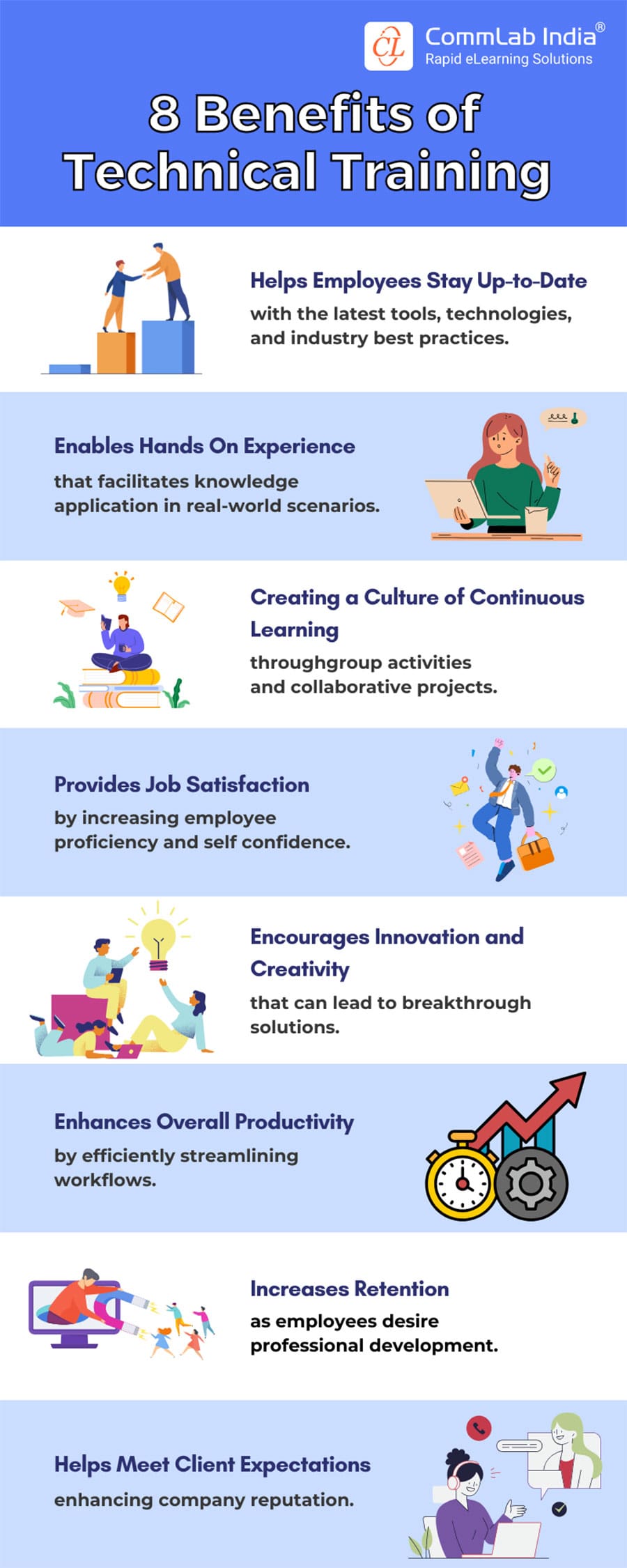Upskilling Workforce with Technical Training — What are the Benefits? [Infographic]
![Upskilling Workforce with Technical Training — What are the Benefits? [Infographic] Upskilling Workforce with Technical Training — What are the Benefits? [Infographic]](https://blog.commlabindia.com/hubfs/blogs/technical-training-benefits-offered-info.jpg)
In today's fast-paced world, staying ahead of the curve isn't just an option, it's a necessity. With new software applications cropping up in every industry, organizations need to ensure their workforce is equipped with the right skills to navigate these technological advancements seamlessly. That's where technical training swoops in! From mastering the nitty-gritty of software applications to keeping their finger on the pulse of industry trends, technical training is the ticket to upskill and reskill employees.
What is Technical Training?
Technical training refers to the training initiatives aimed at equipping employees with the necessary proficiency in the technical aspects related to their job roles. These training programs are meticulously crafted to address the intricacies of various software applications, tools, and processes essential for job execution.
→ Download Now: Are You Ready for Online Training? [Checklist]
What are the Benefits of Technical Training?
How to Kick Start an Effective Technical Training Program?
1. Identify Training Needs
Begin by assessing the technical skills gap within your organization. Determine which specific skills or knowledge areas employees are in need of at work.
2. Define Learning Objectives
Set clear and measurable learning objectives for the training program. These objectives should align with both individual employee development goals and organizational objectives.
3. Choose Training Methods
Select suitable training methods based on the learning preferences and needs of your employees. Consider a mix of instructor-led training, online courses, hands-on workshops, and self-paced learning options.
4. Develop Training Content
Curate high-quality training content that covers the identified technical topics comprehensively. Ensure that the content is engaging, interactive, and relevant to the learners' job roles.
5. Customize Learning Paths
Tailor the training program to accommodate different learning paths for employees with varying skill levels and job roles.
6. Implement Training
Roll out the training program using a structured approach, including clear communication of training schedules, resources, and expectations. Utilize a learning management system (LMS) to deliver and track training progress.
7. Provide Ongoing Support
Offer continuous support and guidance to learners throughout the training program. Encourage participation, address questions and concerns promptly, and provide access to subject matter experts or mentors.
8. Assess Learning Outcomes
Regularly assess the effectiveness of the technical training program through assessments and feedback mechanisms. Use data and insights gathered from assessments to identify and focus on areas of improvement and refinement.
9. Encourage Application and Practice
Encourage employees to apply the acquired technical skills in real-world scenarios. Provide opportunities for hands-on practice, project work, and peer collaboration to reinforce learning and skill retention.
10. Measure Impact and ROI
Evaluate the impact of the technical training program on employee performance, productivity, and job satisfaction. Calculate the ROI by comparing the benefits gained from the training to the costs incurred.
The Future of Technical Training
As we gaze into the horizon of the future, one thing is crystal clear the role of technical training is only set to soar higher. So, let's strap in and gear up because the future of technical training awaits—let's make it nothing short of extraordinary! Explore the essential elements and expert insights to design an unbeatable training strategy for advanced technical training programs. Delve into our detailed checklist and unleash the full potential of online training initiatives to drive your organization's success.




![Online Training — How to Develop Effective Programs [Checklist]](https://no-cache.hubspot.com/cta/default/59327/ae131a0f-e51b-4928-8e55-88f70c46a14e.png)


![Upskilling and Reskilling: How it Helps Overcome Business Challenges [Infographic]](https://blog.commlabindia.com/hubfs/blogs/upskilling-reskilling-overcome-business-cha.jpg)